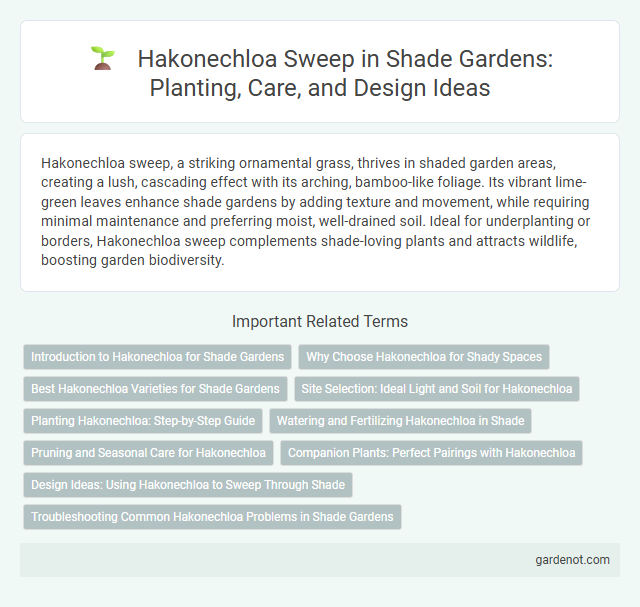Hakonechloa sweep, a striking ornamental grass, thrives in shaded garden areas, creating a lush, cascading effect with its arching, bamboo-like foliage. Its vibrant lime-green leaves enhance shade gardens by adding texture and movement, while requiring minimal maintenance and preferring moist, well-drained soil. Ideal for underplanting or borders, Hakonechloa sweep complements shade-loving plants and attracts wildlife, boosting garden biodiversity.
Introduction to Hakonechloa for Shade Gardens
Hakonechloa macra, commonly known as Hakone grass, thrives in shade gardens by offering vibrant, cascading foliage that brightens low-light areas. This Japanese forest grass is highly valued for its tolerance to partial to full shade and its ability to add texture and movement with its arching blades. Its adaptability to moist, well-drained soils makes Hakonechloa an ideal choice for creating dynamic groundcover in shaded landscape designs.
Why Choose Hakonechloa for Shady Spaces
Hakonechloa, also known as Japanese forest grass, thrives in low-light conditions, making it an ideal choice for shade gardens. Its elegant, arching leaves enhance textural interest while adapting well to moist, well-drained soils commonly found under trees. This shade-tolerant grass also resists pests and disease, providing reliable seasonal color from spring through fall.
Best Hakonechloa Varieties for Shade Gardens
Hakonechloa macra, commonly known as Japanese forest grass, thrives in deep shade and adds graceful texture to shade gardens. Best Hakonechloa varieties for these conditions include 'Aureola' with its vibrant gold-striped leaves, 'All Gold' offering bright yellow foliage, and 'Naomi' featuring compact growth and variegated leaves with creamy margins. These cultivars enhance shady landscapes by providing color contrast and elegant movement under low light.
Site Selection: Ideal Light and Soil for Hakonechloa
Hakonechloa prefers partial to full shade, thriving in dappled sunlight or light morning sun with afternoon shade to prevent leaf scorch. It requires well-drained, moist, and fertile soil rich in organic matter to support healthy growth and vibrant foliage. Consistent moisture retention without waterlogging is essential to maintain its lush appearance in shade garden settings.
Planting Hakonechloa: Step-by-Step Guide
Planting Hakonechloa, commonly known as Japanese forest grass, requires selecting a shaded or partially shaded location with well-draining, moist soil enriched with organic matter. Position each plant 18 to 24 inches apart to allow for its cascading, clumping growth habit and water thoroughly after planting to establish strong roots. Regular mulching helps retain soil moisture and maintain the cool environment Hakonechloa thrives in, ensuring vibrant foliage throughout the growing season.
Watering and Fertilizing Hakonechloa in Shade
Hakonechloa thrives in consistently moist, well-drained soil, requiring regular watering to prevent drying out, especially during hot summer months in shade gardens. Applying a balanced, slow-release fertilizer in early spring supports healthy growth and vibrant foliage, while occasional feeding every 6-8 weeks ensures sustained nutrient availability. Avoid overwatering to prevent root rot, ensuring soil maintains humidity without becoming waterlogged for optimal Hakonechloa vitality.
Pruning and Seasonal Care for Hakonechloa
Pruning Hakonechloa, commonly known as Japanese forest grass, involves cutting back its foliage to about 2-3 inches above the soil in late winter or early spring before new growth begins. Seasonal care includes maintaining moist, well-drained soil and providing partial to full shade to prevent leaf scorch, promoting vibrant golden or green hues depending on the variety. Regular pruning and proper seasonal maintenance enhance Hakonechloa's graceful, arching form and ensure a healthy, vigorous growth cycle.
Companion Plants: Perfect Pairings with Hakonechloa
Hakonechloa, also known as Japanese forest grass, thrives in shaded garden areas when paired with hostas, ferns, and astilbes, which complement its graceful, arching foliage. These companion plants share similar light and moisture preferences, creating a lush, layered texture that enhances the visual appeal of shade gardens. Incorporating spring-blooming hellebores adds seasonal interest and color contrast, making Hakonechloa a versatile component for diverse shade-loving plant groupings.
Design Ideas: Using Hakonechloa to Sweep Through Shade
Hakonechloa macra, commonly known as Japanese forest grass, is ideal for sweeping through shade gardens with its graceful, arching foliage that adds texture and movement. Its vibrant chartreuse to deep green blades create a dynamic ground cover, effectively softening borders and pathways in low-light areas. Integrating Hakonechloa in layered plantings enhances contrast while providing a lush, flowing appearance that complements shaded woodland settings.
Troubleshooting Common Hakonechloa Problems in Shade Gardens
Hakonechloa macra, commonly known as Japanese forest grass, thrives in shade gardens but may encounter issues like yellowing leaves due to excessive sun exposure or improper watering. To troubleshoot common Hakonechloa problems, ensure the soil remains consistently moist but well-drained, avoiding waterlogged conditions that lead to root rot. Regularly check for pests such as slugs and aphids, which can damage foliage, and apply organic pest control methods to maintain healthy plant growth.
Hakonechloa sweep Infographic

 gardenot.com
gardenot.com